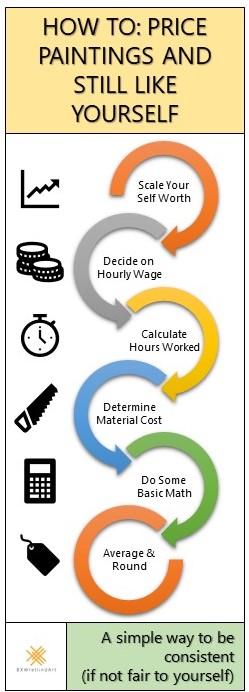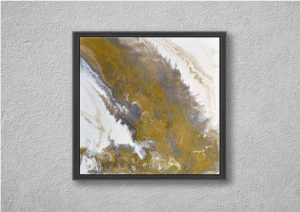How to: Price Paintings and Still Like Yourself
The art of how to price paintings has always been troublesome for me. While I don’t want to pretend anything I do should be priced up there with Andy Warhol or Bob Ross, I like to think that art can be a) profitable for the artist and b) accessible to most collectors.
Assuming, of course, that what I paint is collectible.
It must be: there’s a collection of paintings in my house.
But I digress.
While I could just throw a number on a painting or look at similar artists in my genre to see how they priced things, I wanted a little more meat to my reasoning. Without art being at auction, I asked myself, just what is a good price? So, in an effort to be consistent with my pricing strategy, I scoured the web for various formulas that would help me while not overpricing anything.
Here are the 3 main pricing formulas I’ve found and slightly doctored:
- (A fair hourly rate based on self-esteem x time) + material cost = price
- ((Length of the painting x width of the painting) x self-esteem multiplier) + material cost = price
- ((Length of the painting + width of the painting) x a fair hourly rate based on self-esteem) + material cost = price
The Common Thread & a Scale
Did you notice a common multiplier? It’s called self esteem, and it can make or break the price.
How do you determine what that self-esteem multiplier in formula 2 should be? Do you say 1 and leave it at that? Do you go all out, throw your ego a boost and say 5?
What about a fair hourly rate based on self-esteem for other two formulas? Minimum wage? A lawyer’s hourly rate?
You might ask if it’s fair to base your art on how well you like yourself. Well, is basing your art on how well someone else likes you any better? Probably not.
Frankly, determining a multiplier or an hourly rate is ultimately something you have to answer, but let me throw out a piece of sage advice, something I read on a fortune cookie or something:
Think highly of yourself because the world takes you at your own estimate. – Unknown Author
I’m pretty sure you can guess what U. Author was trying to say: if you come at the world believing your art isn’t fit to decorate the inside of a dumpster behind a butcher’s shop, then you can rest assured the world believes you.
If, on the other hand, you are convinced your art deserves to be in the Louvre (replacing the Mona Lisa because that’s so 16th century)… so what? Your esteem is high.
Now, what’s high? a multiplier of 5? 25? An hourly rate of $400?
For the sake of ease, I’m going to throw out a scale that I have found makes evaluating self-esteem for the purposes of pricing art easier. It’s called the “1 to 5 scale” and it ranges from 1 … to… 5.
- I’m new at this, but my art is not gutter fodder.
- I’ve sold a few pieces and I know I’ll sell more.
- I wonder what galleries will benefit from my work.
- (somewhere between 3 and 5)
- LOOK. AT. ME!
As a start, I will pick a multiplier of 1.
What about the hourly wage for the other formulas? Well, minimum wage in Colorado as of 2020 is $12/hour, but I’m going to say I’ve been painting on an off for a year or five and I’ve earned a few raises which have increased my hourly wage to $20.00.
Now that we have that out of the way, here are some examples.
Example 1
My first example is called Blue Door, a 24×36 acrylic painting I finished and framed a few years ago.
At one point the price on Etsy was$1508. You might think that’s a bit high, but using the above formulas and plugging in my self-esteem multiplier or hourly wage, I can show you that it’s not.
(It’s higher now, but there’s a whole different post waiting to happen on why that is.)
Formula 1: (A fair hourly rate based on self-esteem x time) + material cost = price
I need to know the hourly rate based my self-esteem as well as the material cost. For this particular work of art, I worked for 40 hours total (painting and building the frame). Material cost was roughly $120.00 (canvas, paint, wood, corner accents, hanging hardware).
So…
(20 x 40) + 120 = $920.00
“But that’s not $1508!” you say. No, it’s not. But take a look at the other two formulas.
Formula 2: ((Length of the painting x width of the painting) x self-esteem multiplier) + material cost = price
((36 x 24) x 1) + 120 = $984.00
Formula 3: ((Length of the painting + width of the painting) x a fair hourly rate based on self-esteem) + material cost = price
((36 + 24) x 20 x 1) + 120 = $1320.00
The three formulas each give you a different price. What to do… What to do…
It’s all about consistency for me; if I pick Formula 2 for this painting, I should pick Formula 2 for all my paintings. But you’ll see why I would kick myself for picking Formula 2 in Example 3.
But what if I average all three? Then I get $1074.67, or rounded up, $1075.
And that’s still not $1508. But…if I change the self-esteem multiplier to 2.5 (halfway between “I’ve sold a few pieces and I know I’ll sell more” and “I wonder what galleries will benefit from my work”), then I get $1508 as a final.
Example 2
Here’s another painting, completely different from the last. Gold & Silver is a 12×12 acrylic flow abstract. In this case, the time it took me from start to finish was about 2 hours and the material cost was much, much lower (about $27) since there is no frame (yet). You will see the formulas give a wide rage of answers.
Formula 1: (A fair hourly rate based on self-esteem x time) + material cost = price
(20 x 2) + 27 = $67.00
Formula 2: ((Length of the painting x width of the painting) x self-esteem multiplier) + material cost = price
((12 x 12) x 1) + 27 = $171.00
Formula 3: ((Length of the painting + width of the painting) x a fair hourly rate based on self-esteem) + material cost = price
((12 + 12) x 20 x 1) + 27 = $507.00
And the average of all 3? $248.33, or rounded down , $248.
Example 3
Okay, one more. Stairs, an 11×14 acrylic impressionist painting, is small but includes a custom-built frame. You will also see that the formulas also give very different prices, making the averaging technique worthwhile (for the sake of consistency).
Formula 1: (A fair hourly rate based on self-esteem x time) + material cost = price
(20 x 20) + 49 = $449.00
Formula 2: ((Length of the painting x width of the painting) x self-esteem multiplier) + material cost = price
((11 x 14) x 1) + 49 = $203.00
Formula 3: ((Length of the painting + width of the painting) x a fair hourly rate based on self-esteem) + material cost = price
((11 + 14) x 20 x 1) + 49 = $549.00
Average: $400.33, or rounded down, $400.
So that’s it. Not a lot of math, and in the end the pricing strategy is consistent.
Oh, and one last quote:
It’s not who you are that holds you back. It’s who you think you’re not. – Anonymous






















